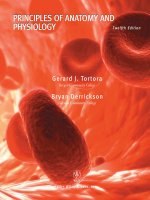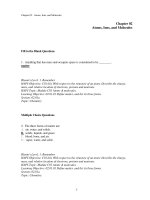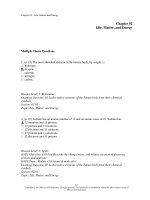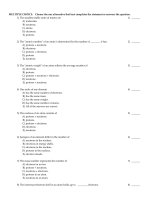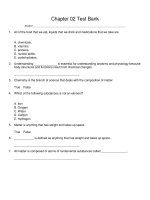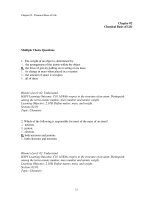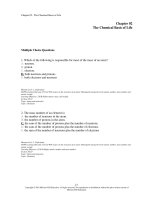Ebook Essentials of anatomy and physiology (7th edition): Part 1
Bạn đang xem bản rút gọn của tài liệu. Xem và tải ngay bản đầy đủ của tài liệu tại đây (10.87 MB, 300 trang )
SEVENTH EDITION
3957_FM_i-001 13/10/14 10:25 AM Page i
SEVENTH EDITION
ESSENTIALS OF
ANATOMY
AND
PHYSIOLOGY
3957_FM_i-001 13/10/14 10:25 AM Page ii
3957_FM_i-001 13/10/14 10:25 AM Page iii
SEVENTH EDITION
ESSENTIALS OF
ANATOMY
AND
PHYSIOLOGY
VALERIE C. SCANLON, PhD
College of Mount Saint Vincent
Riverdale, New York
TINA SANDERS
Medical Illustrator
Castle Creek, New York
Formerly Head Graphic Artist
Tompkins Courtland Community College
Dryden, New York
3957_FM_i-001 13/10/14 10:25 AM Page iv
F. A. Davis Company
1915 Arch Street
Philadelphia, PA 19103
www.fadavis.com
Copyright © 2015 by F. A. Davis Company
Copyright © 2011, 2007, 2003, 1999, 1995, and 1991 by F. A. Davis Company. All rights reserved. This book is protected by copyright. No part of it
may be reproduced, stored in a retrieval system, or transmitted in any form or by any means, electronic, mechanical, photocopying, recording, or
otherwise, without written permission from the publisher.
Printed in the United States of America
Last digit indicates print number: 10 9 8 7 6 5 4 3 2 1
Publisher, Nursing: Lisa B. Houck
Director of Content Development: Darlene D. Pedersen
Content Project Manager: Echo Gerhart
Electronic Project Editor: Katherine Crowley
Manager of Design and Illustration: Carolyn O’Brien
As new scientific information becomes available through basic and clinical research, recommended treatments and drug therapies undergo changes.
The author(s) and publisher have done everything possible to make this book accurate, up to date, and in accord with accepted standards at the time
of publication. The author(s), editors, and publisher are not responsible for errors or omissions or for consequences from application of the book,
and make no warranty, expressed or implied, in regard to the contents of the book. Any practice described in this book should be applied by the reader
in accordance with professional standards of care used in regard to the unique circumstances that may apply in each situation. The reader is advised
always to check product information (package inserts) for changes and new information regarding dose and contraindications before administering
any drug. Caution is especially urged when using new or infrequently ordered drugs.
Library of Congress Cataloging-in-Publication Data
Scanlon, Valerie C., 1946- author.
Essentials of anatomy and physiology / Valerie C. Scanlon, Tina Sanders. — Seventh edition.
p. ; cm.
Includes index.
ISBN 978-0-8036-3957-7
I. Sanders, Tina, 1943- author. II. Title.
[DNLM: 1. Anatomy. 2. Physiological Phenomena. QS 4]
QP34.5
612—dc23
2014012086
Authorization to photocopy items for internal or personal use, or the internal or personal use of specific clients, is granted by F. A. Davis Company
for users registered with the Copyright Clearance Center (CCC) Transactional Reporting Service, provided that the fee of $.25 per copy is paid directly
to CCC, 222 Rosewood Drive, Danvers, MA 01923. For those organizations that have been granted a photocopy license by CCC, a separate system of
payment has been arranged. The fee code for users of the Transactional Reporting Service is: 8036-3957-7/15 0 + $.25.
Proudly sourced and uploaded by [StormRG]
Kickass Torrents | TPB | ExtraTorrent | h33t
3957_FM_i-001 13/10/14 10:25 AM Page v
To my students, past and present
VCS
To Brooks, for his encouragement
TS
3957_FM_i-001 13/10/14 10:25 AM Page vi
3957_FM_i-001 13/10/14 10:25 AM Page vii
PREFACE TO THE SEVENTH EDITION
Once again, we extend our gratitude to all of you who
have used previous editions of Essentials of Anatomy and
Physiology and are considering adopting our seventh edition. We are pleased to welcome new readers as well, and
we thank you for choosing our book.
The seventh edition remains focused on presenting basic
anatomy and physiology with the clarity of the text complemented and enhanced by superb illustrations. The text has
been updated in many small ways to remain contemporary.
These include brief discussions of our microbiota in Chapter
1 (and appropriate later chapters), the oligosaccharides in
breast milk in Chapter 2, epigenetics and primary cilia in
Chapter 3, connective tissue disorders in Chapter 4, motor
units and the muscle hormone irisin in Chapter 7, celiac disease in Chapter 16, human papillomavirus in Chapter 20,
and evaluation of fetal DNA in maternal blood for prenatal
testing in Chapter 21. Chapter 12 has been revised and now
begins with a description of cardiac muscle tissue, pulling
together material from previous chapters.
All of the For Further Thought sections now end with
at least one illustration question. New ones include the
relationship of organ systems in Chapter 1, the hydrogen
bonds formed by water molecules in Chapter 2, effects of
sunlight on the skin in Chapter 5, a nerve pathway (to be
named by the student) in Chapter 8, the hormones of
stressful situations in Chapter 10, a time line of immune
responses in Chapter 14, hormones of the duodenum in
Chapter 16, regulation of body temperature in Chapter 17,
and relationships of the reproductive organs to other
organ systems in Chapter 20. When the students have
labeled the picture and answered the questions, the whole
then becomes an integral part of the chapter. We hope you
will consider assigning these questions, and that students
will find them enjoyable and helpful.
Colleagues, please keep in mind that the Instructor’s
Guide contains a full list of these additions in the “New to
This Edition” section for each chapter of the textbook, as
well as detailed answers to all of the For Further Thought
questions.
As always, your comments and suggestions will be
most welcome, and they may be sent to us in care of the
publisher: F. A. Davis Company, 1915 Arch Street,
Philadelphia, PA 19103.
Valerie C. Scanlon
Dobbs Ferry, New York
Tina Sanders
Castle Creek, New York
vii
3957_FM_i-001 13/10/14 10:25 AM Page viii
3957_FM_i-001 13/10/14 10:25 AM Page ix
TO THE INSTRUCTOR
The start of the 21st century has already brought many advances in the science and art of medicine and health care;
many of these were made possible by research and discoveries in the basic sciences. Teachers of introductory
anatomy and physiology may wish to include some of
these discoveries yet will want to maintain their emphasis
on the normal structure and function of the human body.
Those are the goals of this textbook: to add a little of the
new to the foundation of long-standing knowledge and to
make all of this material readily accessible to students with
diverse backgrounds and varying levels of educational
preparation.
No prior knowledge of biology or chemistry is assumed,
and even fundamental terms are defined thoroughly.
Essential aspects of anatomy are presented clearly and reinforced with excellent illustrations. Essential aspects of
physiology are discussed simply yet with accuracy and precision. The illustrations complement the text material and
foster comprehension on the part of the student. As you
will see, these are images in which detail is readily apparent
and all important parts have been labeled. Illustrations of
physiology lead the student step-by-step. Wherever appropriate, the legends refer students to the text for further description or explanation. Each illustration also has a
question for the student; the illustration questions in each
chapter form an ongoing self-test. (The answers are given
in Appendix G.)
The text has three unifying themes: the relationship
between physiology and anatomy, the interrelations
among the organ systems, and the relationship of each
organ system to homeostasis. Although each type of cell,
tissue, organ, or organ system is discussed simply and
thoroughly in itself, applicable connections are made to
other aspects of the body or to the functioning of the body
as a whole. Our goal is to provide your students with the
essentials of anatomy and physiology, and in doing so, to
help give them a solid foundation for their future work
and an appreciation for the incredible living organism that
is the human body.
The sequence of chapters is a very traditional one.
Cross-references are used to remind students of what they
have learned from previous chapters. Nevertheless, the
textbook is very flexible, and, following the introductory
four chapters, the organ systems may be covered in almost
any order, depending on the needs of your course.
Each chapter is organized from the simple to the more
complex, with the anatomy followed by the physiology.
The Instructor’s Guide presents modifications of the topic
sequences that may be used, again depending on the needs
of your course. Certain more advanced topics may be
omitted from each chapter without losing the meaning or
flow of the rest of the material, and these are indicated, for
each chapter, in the Instructor’s Guide.
Clinical applications are set apart from the text in
boxed inserts. These are often aspects of pathophysiology
that are related to the normal anatomy or physiology in
the text discussion. Each box presents one topic and is
referenced at the appropriate point in the text. This material is intended to be an integral part of the chapter but is
set apart for ease of reference and to enable you to include
or omit as many of these topics as you wish. The use of
these boxes also enables students to read the text material
without interruption and then to focus on specific aspects
of pathophysiology. A comprehensive list of the boxes
appears inside the book’s front and back covers, and
another list at the beginning of each chapter cites the boxes
within that chapter.
Tables are utilized as summaries of structure and function, to present a sequence of events, or additional material
that you may choose to include. Each table is referenced in
the text and is intended to facilitate your teaching and to
help your students learn.
New terms appear in bold type within the text, and all
such terms are fully defined in an extensive glossary, with
phonetic pronunciations. Bold type may also be used for
emphasis whenever one of these terms is used again in a
later chapter.
Each chapter begins with a chapter outline and student
objectives to prepare the student for the chapter itself. New
terminology and related clinical terms are also listed, with
phonetic pronunciations. Each of these terms is fully defined in the glossary, with cross-references back to the
chapter in which the term is introduced.
At the end of each chapter are review questions and a
study outline. The study outline includes all of the essentials of the chapter in a concise form. The review questions
may be assigned as homework or used by the students as
a review or self-test. Following each question is a page reference in parentheses. This reference cites the page(s) in
the chapter on which the content needed to answer the
ix
3957_FM_i-001 13/10/14 10:25 AM Page x
x To The Instructor
question correctly can be found. The answers themselves
are included in the Instructor’s Guide. The questions in
the sections titled For Further Thought may be used in a
variety of ways, and the answers are in the Instructor’s
Guide.
An important supplementary learning tool for your
students is available in the form of a Student Workbook
that accompanies this text. For each chapter in the textbook, the workbook offers fill-in and matching-column
questions, figure-labeling and figure-coloring exercises,
and crossword puzzles based on the chapter’s vocabulary
list. Also included are three comprehensive, multiplechoice chapter tests to provide a thorough review. All
answers are provided at the end of the workbook.
Ancillary materials for the teacher using this text are
all available on the F.A. Davis website (please contact your
F.A. Davis sales representative for access information): a
complete Instructor’s Guide, a test bank using three formats, an Interactive Teaching Tool presentation of the text
illustrations, with related questions for students, podcasts
of the chapter study outlines, and PowerPoint lecture outlines. The Instructor’s Guide contains notes on each chapter’s
organization and content (useful for modifying the book to
your specific teaching needs), topics for class discussion, answers to the chapter review questions from the textbook, and
detailed answers to the For Further Thought questions.
Suggestions and comments from colleagues are always
valuable, and yours would be greatly appreciated. When
we took on the task of writing and illustrating this textbook, we wanted to make it the most useful book possible
for you and your students. Any suggestions that you can
provide to help us achieve that goal are most welcome, and
they may be sent to us in care of F. A. Davis Company,
1915 Arch Street, Philadelphia, PA 19103.
Valerie C. Scanlon
Dobbs Ferry, New York
Tina Sanders
Castle Creek, New York
3957_FM_i-001 13/10/14 10:25 AM Page xi
TO THE STUDENT
This is your textbook for your course in human anatomy
and physiology, a subject that is both fascinating and
rewarding. That you are taking such a course says something about you. You may simply be curious as to how the
human body functions or you may have a personal goal
of making a contribution in one of the health care professions. Whatever your reason, this textbook will help you
to be successful in your anatomy and physiology course.
The material is presented simply and concisely yet
with accuracy and precision. The writing style is informal yet clear and specific; it is intended to promote your
comprehension and understanding.
ORGANIZATION OF THE TEXTBOOK
To use this textbook effectively, you should know the purpose of its various parts. Each chapter is organized in the
following way:
Chapter Outline—This presents the main topics in the
chapter, which correspond to the major headings in
the text.
Student Objectives—These summarize what you
should know after reading and studying the chapter.
These are not questions to be answered, but are,
rather, with the chapter outline, a preview of the
chapter contents.
New Terminology and Related Clinical Terminology—
These are some of the new terms you will come across
in the chapter. Read through these terms before you
read the chapter, but do not attempt to memorize
them just yet. When you have finished the chapter, return to the list and see how many terms you can define. Note those you may not be sure of and look them
up. All of these terms are fully defined in the glossary.
Study Outline—At the end of the chapter, this is a concise summary of the essentials in the chapter. You
may find this outline useful as a quick review before
an exam.
Review Questions—These are also at the end of the
chapter. Your instructor may assign them as homework. If not, the questions may be used as a self-test
to evaluate your comprehension of the chapter’s
content. The page number(s) in parentheses following each question refer you to the page(s) in the
chapter on which the content needed to answer the
question can be found.
For Further Thought—The heading tells you what
these questions are for: thinking. Your instructor
may use these for class discussion, and, if so, please
do not ever be afraid to be mistaken. Contribute,
raise your hand, speak up with your best thoughts,
and listen to those of others. Together you will find
the answers.
OTHER FEATURES WITHIN
EACH CHAPTER
Illustrations—These are an essential part of this textbook. They are intended to help you develop your
own mental picture of the body and its parts and
processes. You may not have thought of mental
pictures as being important, but they are, and each
new one you create is a major step in learning. Each
illustration is referenced in the text, so you will
know when to consult it. With a little concentration,
you will have it in your mind for whenever you need
it. You will see that each illustration has a question
after the legend. These questions provide an ongoing quiz; try to answer each one as you come to it.
The answers are given in Appendix G, just before
the glossary.
Boxes—Discussions of clinical applications are in separate boxes in the text so that you may find them easily. Your instructor may include all or some of these
as required reading. These boxes are an introduction
to pathophysiology.
Bold Type—This is used whenever a new term is introduced, or when an old term is especially important.
The terms in bold type are fully defined in the glossary, which includes phonetic pronunciations.
Tables—This format is used to present material in a
very concise form. Some tables are summaries of
text material and are very useful for a quick review.
Other tables present additional material that complements the text material.
Glossary—Found at the end of the book, the glossary
is your dictionary. All of the terms in bold type
in the text, as well as others, are defined here.
Make use of it, rather than wonder what a word
means. The sooner you have a definition firmly in
your mind, the sooner it is truly part of your
knowledge.
xi
3957_FM_i-001 13/10/14 10:25 AM Page xii
xii To The Student
To make the best use of your study time, a Student
Workbook is available that will help you to focus your
attention on the essentials in each chapter. Also included
are comprehensive chapter tests to help you determine
which topics you have learned thoroughly and which you
may have to review. You will find it very helpful.
SOME FINAL WORDS
OF ENCOURAGEMENT
Your success in this course depends to a great extent on
you. Try to set aside study time for yourself every day; a
little time each day is usually much more productive than
trying to cram at the last minute.
Ask questions of yourself as you are studying. What
kinds of questions? The simplest ones. If you are studying
a part of the body such as an organ, ask yourself: What is
its name? Where is it? What is it made of? What does it
do? That is: name, location, structure, and function. These
are the essentials. If you are studying a process, ask yourself: What is happening here? What is its purpose? That
is: What is going on? And what good is it? Again, these
are the essentials.
We hope this textbook will contribute to your success
in this course and in your education.
Valerie C. Scanlon
Dobbs Ferry, New York
Tina Sanders
Castle Creek, New York
3957_FM_i-001 13/10/14 10:25 AM Page xiii
ACKNOWLEDGMENTS
Writing and illustrating are part of a book, yet never the whole, and we thank the editors
and production staff of the F. A. Davis Company, especially:
• Lisa B. Houck, Publisher, Nursing
• Echo K. Gerhart, Content Project Manager
• Jean Rodenberger, Editor in Chief, Nursing
• Michael Bailey, Director of Production
• Bob Butler, Production Manager
• Daniel E. Domzalski, Illustration Coordinator
• Production Editors Chris Waller and Kelly Boutross, Tom Klonoski, Allison
Repking, and everyone else at Graphic World who participated in this project
• Carolyn O’Brien, Illustration and Design Manager, for designing the layout and
the cover
• Neil Kelly, Director of Sales, and all of the F. A. Davis sales representatives
VCS
TS
xiii
3957_FM_i-001 13/10/14 10:25 AM Page xiv
3957_FM_i-001 13/10/14 10:25 AM Page xv
CONTENTS
Chapter 1
Chapter 5
ORGANIZATION AND GENERAL PLAN
OF THE BODY
2
THE INTEGUMENTARY SYSTEM
102
The Skin,
Subcutaneous Tissue,
Aging and the Integumentary System,
104
114
115
Levels of Organization,
4
Metabolism and Homeostasis,
11
Terminology and General Plan of the Body, 13
Chapter 6
Chapter 2
SOME BASIC CHEMISTRY
26
Elements,
Atoms,
Chemical Bonds,
Chemical Reactions,
Inorganic Compounds of Importance,
Organic Compounds of Importance,
28
28
29
32
32
37
Chapter 3
CELLS
56
Cell Structure,
Cellular Transport Mechanisms,
The Genetic Code and Protein Synthesis,
Cell Division,
Aging and Cells,
58
62
67
71
75
Chapter 4
TISSUES AND MEMBRANES
80
Epithelial Tissue,
Connective Tissue,
Muscle Tissue,
Nerve Tissue,
Membranes,
Aging and Tissues,
82
86
91
93
94
97
THE SKELETAL SYSTEM
120
Functions of the Skeleton,
Types of Bone Tissue,
Classification of Bones,
Embryonic Growth of Bone,
Factors That Affect Bone Growth
and Maintenance,
The Skeleton,
Joints—Articulations,
Aging and the Skeletal System,
122
122
122
122
125
128
142
146
Chapter 7
THE MUSCULAR SYSTEM
152
Muscle Structure,
Muscle Tone,
Muscle Sense,
Energy Sources for Muscle Contraction,
Muscle Fiber—Microscopic Structure,
Contraction—The Sliding Filament
Mechanism,
Responses to Exercise—Maintaining
Homeostasis,
Aging and the Muscular System,
Major Muscles of the Body,
154
156
157
158
158
160
164
164
166
xv
3957_FM_i-001 13/10/14 10:25 AM Page xvi
xvi Contents
Chapter 8
THE NERVOUS SYSTEM
184
Nervous System Divisions,
Nerve Tissue,
The Nerve Impulse,
Types of Neurons,
Nerves and Nerve Tracts,
The Spinal Cord,
The Brain,
Meninges and Cerebrospinal Fluid,
Cranial Nerves,
The Autonomic Nervous System,
Aging and the Nervous System,
186
186
190
192
194
194
198
206
209
209
215
Chapter 9
THE SENSES
222
Sensory Pathway,
Characteristics of Sensations,
Cutaneous Senses,
Muscle Sense,
Sense of Taste,
Sense of Smell,
Hunger and Thirst,
The Eye,
The Ear,
Arterial Receptors,
Aging and the Senses,
224
224
225
228
228
228
230
230
239
244
244
Chapter 10
THE ENDOCRINE SYSTEM
252
Chemistry of Hormones,
Regulation of Hormone Secretion,
The Pituitary Gland,
Thyroid Gland,
Parathyroid Glands,
Pancreas,
Adrenal Glands,
254
256
256
261
264
264
269
Ovaries,
Testes,
Other Hormones,
Mechanisms of Hormone Action,
Aging and the Endocrine System,
272
275
275
275
277
Chapter 11
BLOOD
282
Characteristics of Blood,
Plasma,
Blood Cells,
284
284
284
Chapter 12
THE HEART
306
Cardiac Muscle Tissue,
Location and Pericardial Membranes,
Chambers—Vessels and Valves,
Coronary Vessels,
Cardiac Cycle and Heart Sounds,
Cardiac Conduction Pathway,
Heart Rate,
Cardiac Output,
Regulation of Heart Rate,
Aging and the Heart,
308
309
309
310
312
315
316
318
319
321
Chapter 13
THE VASCULAR SYSTEM
326
Arteries,
Veins,
Capillaries,
Pathways of Circulation,
Velocity of Blood Flow,
Blood Pressure,
Regulation of Blood Pressure,
Aging and the Vascular System,
328
328
331
331
341
342
348
349
3957_FM_i-001 13/10/14 10:25 AM Page xvii
Contents
Chapter 14
xvii
Chapter 17
THE LYMPHATIC SYSTEM
AND IMMUNITY
356
Lymph,
Lymph Vessels,
Lymphatic Tissue,
Immunity,
Aging and the Lymphatic System,
358
358
358
363
374
Chapter 15
THE RESPIRATORY SYSTEM
380
Divisions of the Respiratory System,
Mechanism of Breathing,
Pulmonary Volumes,
Exchange of Gases,
Transport of Gases in the Blood,
Regulation of Respiration,
Respiration and Acid–Base Balance,
Aging and the Respiratory System,
382
388
391
394
396
398
401
401
Chapter 16
THE DIGESTIVE SYSTEM
408
Divisions of the Digestive System,
Types of Digestion,
Oral Cavity,
Pharynx,
Esophagus,
Structural Layers of the Alimentary Tube,
Stomach,
Small Intestine,
Liver,
Gallbladder,
Pancreas,
Completion of Digestion and Absorption,
Large Intestine,
Other Functions of the Liver,
Aging and the Digestive System,
410
410
412
413
414
414
417
418
419
421
422
422
425
428
430
BODY TEMPERATURE
AND METABOLISM
436
Body Temperature,
Metabolism,
Aging and Metabolism,
438
442
455
Chapter 18
THE URINARY SYSTEM
460
Kidneys,
Formation of Urine,
The Kidneys and Acid–Base Balance,
Other Functions of the Kidneys,
Elimination of Urine,
Characteristics of Urine,
Aging and the Urinary System,
463
465
470
472
473
475
476
Chapter 19
FLUID–ELECTROLYTE
AND ACID–BASE BALANCE
482
Water Compartments,
Water Intake and Output,
Electrolytes,
Acid–Base Balance,
Aging and Fluid and pH Regulation,
484
485
487
489
492
Chapter 20
THE REPRODUCTIVE SYSTEMS
498
Meiosis,
Male Reproductive System,
Female Reproductive System,
Aging and the Reproductive Systems,
500
500
507
513
Chapter 21
HUMAN DEVELOPMENT
AND GENETICS
520
Human Development,
Genetics,
522
533
3957_FM_i-001 13/10/14 10:25 AM Page xviii
xviii Contents
Chapter 22
AN INTRODUCTION TO
MICROBIOLOGY AND
HUMAN DISEASE
544
Classification of Microorganisms,
Normal Flora—Microbiota,
Infectious Disease,
Epidemiology,
Methods of Control of Microbes,
The Pathogens,
546
548
548
551
553
555
APPENDIXES
A Units of Measure,
B Abbreviations,
582
584
C Normal Values for Some Commonly
Used Blood Tests,
D Normal Values for Some Commonly
Used Urine Tests,
E Eponymous Terms,
F Prefixes, Combining Word Roots,
and Suffixes Used in Medical
Terminology,
G Answers to Illustration Questions,
587
589
590
591
595
GLOSSARY
603
INDEX
653
3957_FM_i-001 13/10/14 10:25 AM Page 1
SEVENTH EDITION
ESSENTIALS OF
ANATOMY
AND
PHYSIOLOGY
3957_Ch01_002-025 06/10/14 10:25 AM Page 2
CHAPTER
Organization and
General Plan
of the Body
3957_Ch01_002-025 06/10/14 10:25 AM Page 3
STUDENT OBJECTIVES
Define the terms anatomy, physiology, and pathophysiology. Use an
example to explain how they are related.
■ Name the levels of organization of the body from simplest to most
complex, and explain each.
■ Define the terms metabolism, metabolic rate, and homeostasis, and use
examples to explain each.
■ Explain how a negative feedback mechanism works and how a positive
feedback mechanism differs.
■ Describe the anatomic position.
■ State the anatomic terms for the parts of the body.
■ Use proper terminology to describe the location of body parts with respect
to one another.
■ Name the body cavities, their membranes, and some organs within each
cavity.
■ Describe the possible sections through the body or an organ.
■ Explain how and why the abdomen is divided into smaller areas. Be able
to name organs in these areas.
■
NEW TERMINOLOGY
Anatomy (uh-NAT-uh-mee)
Body cavity (BAH-dee KAV-i-tee)
Cell (SELL)
Homeostasis (HOH-me-oh-STAY-sis)
Inorganic chemicals (IN-or-GAN-ik
KEM-i-kuls)
Meninges (me-NIN-jeez)
Metabolism (muh-TAB-uh-lizm)
Microbiota (MY-kroh-bye-OH-ta)
Microbiome (MY-kroh-BYE-ohm)
Negative feedback (NEG-ah-tiv
FEED-bak)
Organ (OR-gan)
Organ system (OR-gan SIS-tem)
Organic chemicals (or-GAN-ik
KEM-i-kuls)
Pathophysiology (PATH-oh-FIZZ-eeAH-luh-jee)
Pericardial membranes (PER-eeKAR-dee-uhl MEM-brayns)
Peritoneum-mesentery (PER-i-tohNEE-um MEZ-en-TER-ee)
Physiology (FIZZ-ee-AH-luh-jee)
Plane (PLAYN)
Pleural membranes (PLOOR-uhl
MEM-brayns)
Positive feedback (PAHS-ah-tiv
FEED-bak)
Section (SEK-shun)
Tissue (TISH-yoo)
RELATED CLINICAL
TERMINOLOGY
Computed tomography (CT) scan
(kom-PEW-ted toh-MAH-grah-fee
SKAN)
Diagnosis (DYE-ag-NOH-sis)
Disease (di-ZEEZ)
Magnetic resonance imaging
(MRI) (mag-NET-ik REZ-uhnanse IM-ah-jing)
Positron emission tomography
(PET) (PAHZ-i-tron e-MISH-un
toh-MAH-grah-fee)
CHAPTER OUTLINE
Levels of Organization
Chemicals
Cells
Tissues
Organs
Organ Systems
The Rest of “Us”
Metabolism and
Homeostasis
Terminology and General
Plan of the Body
Body Parts and Areas
Terms of Location and Position
Body Cavities and Their
Membranes
Cranial and Spinal Cavities
Thoracic, Abdominal, and
Pelvic Cavities
Planes and Sections
Areas of the Abdomen
BOX 1–1
Replacing Tissues and
Organs
BOX 1–2
Visualizing the Interior
of the Body
BOX 1–3
Watching the Brain at
Work
Terms that appear in bold type in the chapter text are defined in the glossary,
which begins on page 603.
3
3957_Ch01_002-025 06/10/14 10:25 AM Page 4
4 Organization and General Plan of the Body
T
he human body is a precisely structured container
of chemicals and chemical reactions. Have you ever
thought of yourself in this way? Probably not, and
yet, in the strictly physical sense, that is what each of us is.
The body consists of trillions of atoms in specific arrangements (the chemicals) and thousands of chemical reactions proceeding in a very orderly manner. That literally
describes us, and yet it is clearly not the whole story. The
keys to understanding human consciousness and selfawareness are still beyond our grasp. We do not yet know
what enables us to study ourselves—no other animals do,
as far as we know—but we have accumulated a great deal
of knowledge about what we are made of and how it all
works. Some of this knowledge makes up the course you
are about to take, a course in basic human anatomy and
physiology.
Anatomy is the study of body structure, which includes size, shape, composition, and perhaps even coloration. Physiology is the study of how the body
functions. The physiology of red blood cells, for example,
includes what these cells do, how they do it, and how this
is related to the functioning of the rest of the body. Physiology is directly related to anatomy. For example, red
blood cells contain the mineral iron in molecules of the
protein called hemoglobin; this is an aspect of their
anatomy. The presence of iron enables red blood cells to
carry oxygen, which is their function. All cells in the body
must receive oxygen in order to function properly, so the
physiology of red blood cells is essential to the physiology
of the body as a whole.
Pathophysiology is the study of disorders of functioning, and a knowledge of normal physiology makes such
disorders easier to understand. For example, you are probably familiar with the anemia called iron-deficiency anemia. With insufficient iron in the diet, there will not be
enough iron in the hemoglobin of red blood cells, and
hence less oxygen will be transported throughout the
body, resulting in the symptoms of the iron-deficiency disorder. This example shows the relationship among
anatomy, physiology, and pathophysiology.
The purpose of this text is to enable you to gain an
understanding of anatomy and physiology with an emphasis on normal structure and function. Many examples
of pathophysiology have been included, however, to illustrate the relationship of disease to normal physiology
and to describe some of the procedures used in the diagnosis of disease. Many of the examples are clinical applications that will help you begin to apply what you have
learned. Your knowledge of anatomy and physiology
will become the basis for your further study in the health
professions.
LEVELS OF ORGANIZATION
The human body is organized into structural and functional levels of increasing complexity. Each higher level
incorporates the structures and functions of the previous
level, as you will see. We will begin with the simplest level,
which is the chemical level, and proceed to cells, tissues,
organs, and organ systems. All of the levels of organization
are depicted in Fig. 1–1.
CHEMICALS
Recall that the body is a container of chemicals. The chemicals that make up the body may be divided into two major
categories: inorganic and organic. Inorganic chemicals are
usually simple molecules made of one or two elements other
than carbon (with a few exceptions). Examples of inorganic
chemicals are water (H2O); oxygen (O2); one of the exceptions, carbon dioxide (CO2); and minerals such as iron (Fe)
in hemoglobin, sodium (Na) in the salt sodium chloride
that makes tears salty, and calcium (Ca) in the calcium salts
that make bones hard. Organic chemicals are often very
complex and always contain the elements carbon and hydrogen. In the category of organic chemicals are carbohydrates, fats, proteins, and nucleic acids. The chemical
organization of the body is the subject of Chapter 2.
CELLS
The smallest living units of structure and function are
cells, and the human body consists of more than 200 different types of cells. Another way to think of the body
is as a city of cells. Just as a large city has millions of people with many different jobs, the body contains trillions
of cells that perform more than 200 jobs. Despite these
different functions, human cells have certain structural
similarities. Each type of cell is made of chemicals and
carries out specific chemical reactions. Cell structure
and function are discussed in Chapter 3.
TISSUES
A tissue is a group of cells with similar structure and function. Just as in a city certain groups of individuals work
together (in the fire department, for example) to keep the
city functioning, groups of similar cells work together in
the body. There are four groups of tissues:
Epithelial tissues—cover or line body surfaces; some are
capable of producing secretions with specific functions.
3957_Ch01_002-025 06/10/14 10:25 AM Page 5
Organization and General Plan of the Body
1. Chemical Level
2. Cellular Level
Cuboidal epithelium
Squamous epithelium
Smooth muscle
3. Tissue Level
Kidney
Urinary
bladder
4. Organ Level
Urinary
system
6. Organism Level
5. Organ System
Level
Figure 1–1 Levels of structural organization of the human body, depicted from the simplest
(chemical) to the most complex (organism). The organ system shown here is the urinary system.
QUESTION: What other organ system seems to work directly with the urinary system?
5
3957_Ch01_002-025 06/10/14 10:25 AM Page 6
6 Organization and General Plan of the Body
The outer layer of the skin and sweat glands are examples of epithelial tissues. Internal epithelial tissues
include the walls of capillaries (squamous epithelium)
and the kidney tubules (cuboidal epithelium), as shown
in Fig. 1–1.
Connective tissues—connect and support parts of the
body; some transport or store materials. Blood, bone,
cartilage, and adipose tissue are examples of this
group.
Muscle tissues—are specialized for contraction, which
brings about movement. Our skeletal muscles and the
heart are examples of muscle tissue. In Fig. 1–1, you see
smooth muscle tissue, which is found in organs such
as the urinary bladder and stomach.
Nerve tissues—specialized to generate and transmit electrochemical impulses that regulate body functions.
The brain and the optic nerves are examples of nerve
tissue.
The types of tissues in these four groups, as well as their
specific functions, are the subject of Chapter 4.
ORGANS
An organ is a group of tissues precisely arranged so as to
accomplish specific functions. Examples of organs are the
kidneys, individual bones, the liver, the lungs, and the
stomach. The kidneys contain several kinds of epithelial,
or surface tissues, for their work of absorption. The stomach is lined with epithelial tissue that secretes gastric juice
for digestion, especially of proteins. Smooth muscle tissue
in the wall of the stomach contracts to mix food with gastric juice and propel it to the small intestine. Nerve tissue
carries impulses that increase or decrease the contractions
of the stomach. An organ may be considered a “cooperation of tissues,” in which the whole is the anatomic sum
of its parts, and much more than the physiologic sum.
None of the tissues of the kidney can remove waste products from the blood by itself, but the functioning of all of
the kidney tissues does so. Similarly, none of the tissues of
the stomach can by itself begin the digestion of protein,
but the stomach as a whole can (see Box 1–1: Replacing
Tissues and Organs).
ORGAN SYSTEMS
An organ system is a group of organs that all contribute
to a particular function. Examples are the urinary system, the digestive system, and the respiratory system. In
Fig. 1–1 you see the urinary system, which consists of
the kidneys, ureters, urinary bladder, and urethra. These
organs all contribute to the formation and elimination
of urine.
As a starting point, Table 1–1 lists the organ systems
of the human body with their general functions and
some representative organs, and Fig. 1–2 depicts all of
the organ systems. Many of these are already familiar
to you. Some organs are part of two organ systems; the
pancreas, for example, is both a digestive organ and an
endocrine organ, and the diaphragm is part of both the
muscular system and the respiratory system. All of the
organ systems make up an individual person, and all of
them function together; that is, they are interdependent.
For now, a few examples will give you an idea of the
many interactions among the systems. All cells in the
body require oxygen. The respiratory system obtains
oxygen from the atmosphere, and the circulatory system
distributes the oxygen. All cells need nutrients. The digestive system gets the nutrients, and the circulatory system distributes them. All cells produce waste products.
The circulatory system collects the waste products, and
the urinary system eliminates them from the blood. The
balance of this text discusses each system and its interactions with other systems in more detail.
THE REST OF “US”
We are not alone. Every human being lives with an enormous population of bacteria and other microorganisms,
our microbiota. It is estimated that the total bacteria that
reside on us or inside us, with the most in the intestines,
outnumber our own cells about 10 to 1. An older name
for this population is normal flora (or resident flora, see
Table 22–1 for their distribution), and different people
have different proportions of the hundreds of species
that make us their home. Each site on or inside the body
that has bacteria is considered a small ecosystem called
a microbiome. We have known for years that some intestinal bacteria produce vitamins that we absorb, especially vitamin K. We have also known that these bacteria,
in their usual body site (surface of the skin, oral cavity,
the vagina in women, among other microbiomes), help
to prevent the growth of pathogens. This knowledge
has been used lately to try to help those with antibioticresistant Clostridium difficile intestinal infections, and
some people have been cured by “fecal transplants” (in
capsule form) of intestinal bacteria from a healthy family
member.
